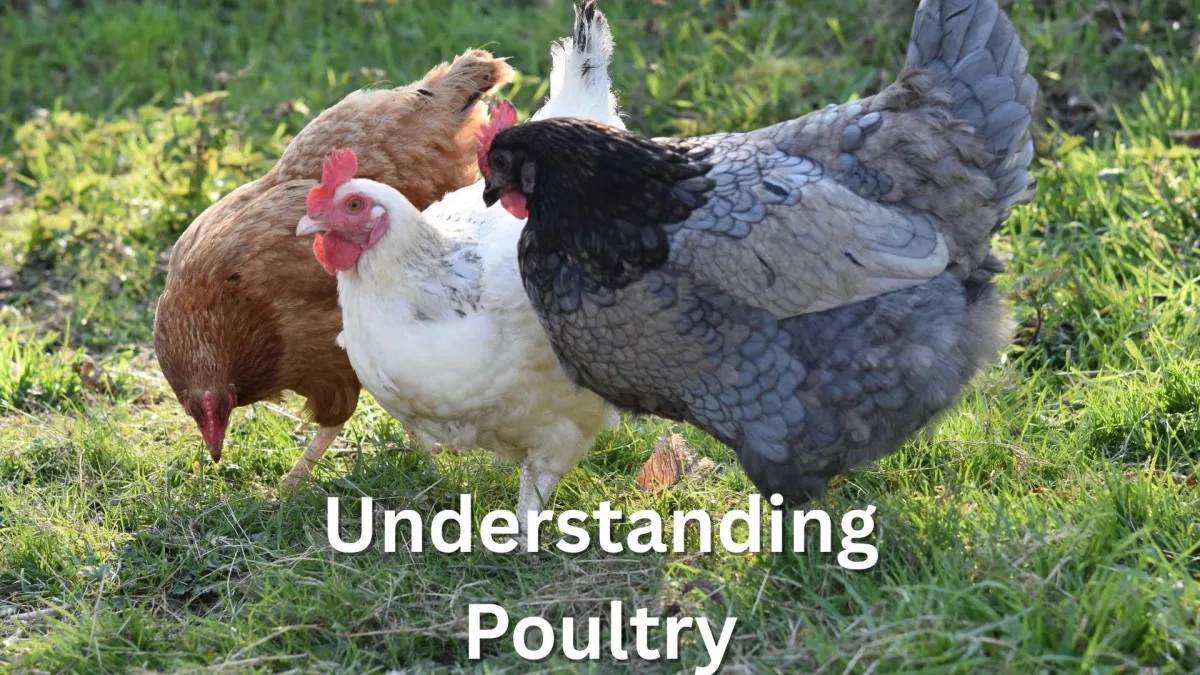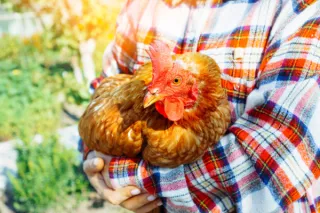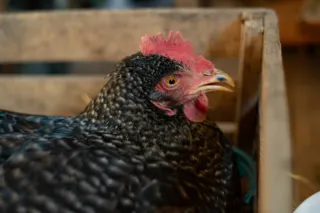Understanding Poultry

Behaviour, senses, and management for backyard and lifestyle block flocks
Keeping poultry is one of the most rewarding and sometimes surprising parts of a lifestyle block. Whether you’re raising hens for eggs, meat birds for the freezer, or just a few backyard characters for fun, understanding how poultry think and behave will help you keep them healthy, productive, and stress-free.
This guide is grounded in practical, real-world experience and expert knowledge, especially from the work of Dr Clive Dalton. It focuses primarily on chickens, but the same principles apply to ducks, turkeys, and other common birds.
How Poultry See the World
Vision
Chickens rely heavily on sight. Their vision is sharper and more colourful than ours, with excellent motion detection and a wider field of view. They can see in ultraviolet and pick up on details we miss entirely.
However, they don’t see well in low light. Their depth perception is poor when looking straight ahead, so they tend to tilt their heads to judge distance or investigate new objects.
Because of this, changes to their environment like a new feeder, a brightly coloured bucket, or a sudden shadow can spook them. Avoid quick movements or abrupt changes when working with your birds.
Hearing
Chickens have good hearing and begin responding to sound before they hatch. They learn to recognise your voice, associate noises with routines like feeding, and use vocal cues to warn each other of danger.
Sudden loud noises such as machinery, dogs barking, or shouting can startle them and cause stress. Calm speech and predictable movements are best.
Smell
Their sense of smell is better than previously believed. While not as strong as mammals, chickens can identify familiar flock members, feed, or bedding by scent.
They also respond to strong or unpleasant smells in the coop environment.
Social Behaviour and the Pecking Order
Chickens are flock animals and thrive in stable social groups. Every flock has a pecking order, a social hierarchy that determines who eats first, who roosts where, and who leads flock movements.
Establishing the order involves posturing, feather ruffling, chasing, or pecking.
This behaviour is normal unless it becomes aggressive or causes injury. Problems usually arise when space is limited, new birds are introduced too quickly, or resources are unevenly distributed.
Adding new birds gradually and offering multiple feeders and waterers can ease the process.
Daily Patterns and Routines
Chickens are creatures of habit. Their day follows a rhythm:
Wake at first light
Forage and scratch for food
Dust bathe and socialise
Rest in the afternoon
Roost at dusk
They need opportunities to perform these natural behaviours. If confined too long or kept in a dull environment, they can develop stress behaviours like feather pecking or pacing.
Provide enrichment such as:
Logs and perches
Hanging greens or treat balls
Dust baths with dry soil or wood ash
Space to forage or scratch
Communication
Vocalisations
Chickens use over 20 distinct vocalisations, from alarm calls to nesting sounds. Some key ones include:
Clucks: normal chatter
Cackling: post-egg-laying vocalisation
Growls: territorial warning
Purring: contentment
Alarm calls: high-pitched and urgent, warning others of predators
They also communicate through posture such as fluffed feathers, stretched necks, lowered wings, and more.
Roosters use sound and body language to assert dominance and protect the flock, while hens call to chicks and signal nesting behaviour.
Breeding and Broodiness
Some hens will go broody, sitting on a clutch of eggs and trying to hatch them. Breeds vary in broodiness, but when it strikes, the hen becomes determined and protective.
A broody hen will:
Remain in the nest for long periods
Fluff up and growl when approached
Stop laying eggs
Reduce eating and drinking
If you want her to hatch eggs, leave her undisturbed in a safe, dry, quiet spot. If not, you may need to break the broodiness by removing her from the nest and reducing nesting stimuli.
Handling and Interaction
Handle birds gently and regularly from a young age. Avoid chasing them around the run. This increases stress and makes catching harder next time.
Instead:
Approach slowly and from the side
Scoop from underneath, supporting the body
Keep the bird close to your body to reduce flapping
Routine handling for health checks, trimming claws, or moving birds is easier when they’re accustomed to human contact.
Housing and Coop Behaviour
A safe, clean, and dry coop is essential. Poor housing leads to stress, disease, and behaviour problems.
Key elements include:
Adequate roosting space (20–25 cm per bird)
Nest boxes (1 per 3–4 hens)
Good ventilation without drafts
Secure doors and predator-proof design
Clean bedding, replaced regularly
Observe roosting behaviour in the evenings. Birds that refuse to roost may be sick, bullied, or too low in the pecking order to claim a perch.
Flock Health and Stress
Watch for changes in:
Feeding or drinking
Roosting position
Feather condition
Behaviour such as lethargy, aggression, or isolation
Chickens hide illness well. By the time they look truly unwell, they’ve often been struggling for some time.
Stress is a major factor in illness and poor laying. Reduce stress by:
Keeping flocks stable
Managing parasites like mites, lice, and worms
Avoiding overcrowding
Providing consistent routines
Final Thoughts
Chickens are more than egg machines. They are intelligent, social, expressive animals that bring personality and rhythm to any block. By understanding their behaviour, needs, and social structure, you can create a healthier, calmer, and more productive flock.
Whether you’ve got two hens or twenty, a well-managed coop and an observant keeper make all the difference.
More Resources
If you want a happy, productive flock here's some helpful advice:
What You Need to Know to Keep Chickens – Everything you need for a healthy, happy flock.
What You Need to Know to Keep Livestock – If you're going to keep livestock of any kind you need to know the basics.
Looking for more than chooks?
Understanding Goats – Heaps of character but can be tricky to manage!
Understanding Pigs – Intelligent and full of character.
Understanding Pets on the Block - It's different out here in the country.
Back to Livestock & Pets
More articles on poultry

Keeping ducks
Ducks are endearing creatures and they make friendly and lovable pets, even if they can be a bit messy! What's so good about them? ...more
Poultry
April 12, 2025•6 min read

Dealing with an emergency (while waiting for the vet)
When an emergency strikes your livestock, quick action is key. While waiting for the vet, follow these essential steps to keep your animal safe, calm, and stable. Learn how to secure the patient, mana... ...more
The Basics ,Sheep Cattle Poultry &Pigs
February 24, 2025•8 min read

Be ready for bird flu
Prepare your lifestyle block for bird flu. Learn how to safeguard poultry and pet birds with practical tips to prevent the spread of HPAI H5N1. Keep your birds safe from wild bird contamination and ot... ...more
Poultry
November 20, 2024•2 min read

What You Need To Know When Rehoming Commercial Ex-layers
Discover everything you need to know about rehoming ex-commercial layer hens in New Zealand. Learn how to care for these high-laying but fragile hens, address common health challenges, and enjoy the r... ...more
Poultry
November 14, 2024•6 min read

A Homeowner's Guide to Chicken Health Checks
For anyone caring for chooks, it is crucial to learn how to read their pain behaviors to identity issues early. From there, identifying what may be going on for the bird can be a whole other ball game... ...more
Poultry
October 15, 2024•7 min read

How to care for the unwell hen at home
Chickens are exceptionally good at hiding pain and distress- so much so, that “chickens just drop dead” is a common complaint of poultry owners. This is no more true than for the pet cat or dog, and i... ...more
Poultry
July 23, 2024•7 min read
Support & Legal
Get Rural Tips & Seasonal Updates
Subscribe to the LSB monthly newsletter.
© 2025 Lifestyleblock.co.nz | LSB Ltd Proudly off-grid and NZ-owned

